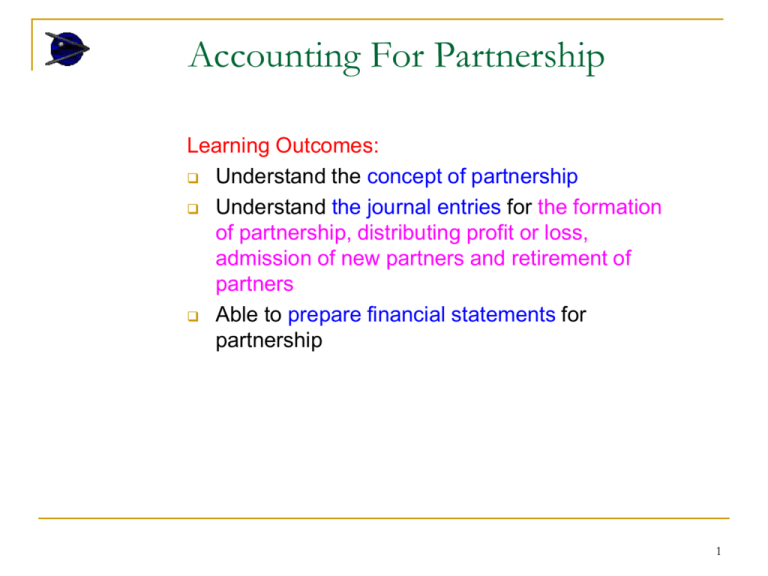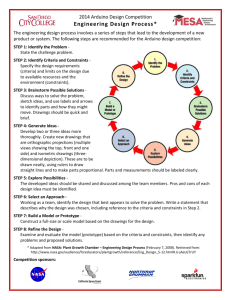ACT 3216 ADVANCED FINANCIAL ACCOUNTING 1
advertisement

Accounting For Partnership Learning Outcomes: Understand the concept of partnership Understand the journal entries for the formation of partnership, distributing profit or loss, admission of new partners and retirement of partners Able to prepare financial statements for partnership 1 Definition Partnership Act 1961 “… is the relation which subsists between persons carrying on business in common with a view of profit.” Sec 3(1) 2 Characteristics Separate legal personality (for the purpose of financial reporting only) Unlimited liability Limited life Co-ownership of property Co-ownership of profits 3 Advantages & Disadvantages Advantages Ease of formation and dissolution Better management Greater capital compared to proprietorship Disadvantages Easily dissolved/limited life Unlimited liability Difficulty in transferring ownership Conflict among partners Lesser capital compared to corporation 4 Formation Minimum members is 2 and should not exceed 20. Not necessarily in the form of written agreement. Verbal agreement is accepted. All matters related to partnership must be referred to an agreement. If no agreement exists in relation to certain issues, statutes in the Partnership Act 1961 would be applied. 5 Partnership Agreement This agreement is framework which governs the formation, operations, dissolution and liquidation of the partnership Contents: Name, nature & scope of partnership Authority, rights & duties of each partner Methods of sharing profits & losses Rates of interest for capital & drawings Salaries Provision for arbitration of disputes & liquidation of the partnership 6 Cont. When no partnership agreement exists: Profits and losses are to be shared equally No interest allowed on capital No interest to be charged on drawings No salaries are allowed Interest 8% p.a. is charged on the advance (loan) made by a partner to the partnership Each partner has unlimited liability. 7 Partnership vs Proprietorship Proprietorship Net Profit Partnership Net Profit Partner’s Account Balance Sheet Balance Sheet 8 Reporting Equity in BS Two methods available to present the equity in the balance sheet: i. Fixed Capital Account ii. Fluctuating Capital Accounts The capital account will record the initial introduction of capital, and will normally only be adjusted if the partner introduces additional capital. 9 Cont. The current account will record transactions relating to partners other than transactions related to capital such as share of profits/losses, interest on withdrawals, interest on loan etc. If the partnership maintains fluctuating capital accounts, there will be no current account, and appropriations of profit and drawings will be recorded in the capital account. 10 Cont. Fixed Capital Account Capital Account Ali Abu Bank Ali Abu 2,000 6,000 11 Cont. Fixed Capital Account Current Account Ali Abu Drawings 2,000 2,000 Int. on drawings 50 100 600 400 2,650 2,500 Bal. c/d Ali Abu Int. on capital 100 300 Profits 2,550 1,700 Salaries Bal. b/d 500 2,650 2,500 600 400 12 Cont. Fluctuating Capital Account Capital Account Ali Abu Drawings 2,000 2,000 Int. on drawings 50 100 2,600 6,400 Bal. c/d Ali Abu 2,000 6,000 Int. on capital 100 300 Profits 2,550 Bank Salaries 4,650 8,500 Bal. b/d 1,700 4,650 500 8,500 2,600 6,400 13 Cont. See Illustration 1 from Siti et al (2008), PA, p. 8 14 Accounting Treatments Initial Investment Initial investment made by partners will be credited into their respective Capital Account. Non cash assets need to be recorded at their fair value at the date of investment. Liabilities brought into the partnership have to be recorded at fair value. 15 Accounting Treatments Additional Investment Similar accounting entries as to the initial investment: Record asset at it’s fair value Credit the amount to partner’s capital account Withdrawal of Investment The withdrawal amount needs to be debited to partner’s capital account 16 Cont. Loan Any loan provided by a partner is a liability to the partnership. This partner is entitled to receive a certain percentage of interest on the loan given. Interest on loan will be treated as expenses of the firm & will be recorded in income statement. Interest on capital Interest was given for the purpose of encouraging partners to invest in the business. 17 Cont. Other issues All amounts received by each partner for the current period (e.g. salaries, interest on capital, profit-loss, bonus etc.) would be credited to respective partner’s Current Account. A key point to remember is that as in a sole trader's accounts, any amounts actually paid to the owners (whether in cash or in kind) should be treated as drawings. 18 Cont. If a partner is entitled to a salary, it is dealt with as part of the appropriation of profit. It is not an expense of the business, and should not be charged to the income statement in order to calculate profit. Only salaries paid to employees of the business are charged to the income statement. 19 Cont. Residual Profit Profit which is divided between the partners in the profit and loss sharing ratio. It is the amount of profit remaining after taking into account the fact that the partners will be entitled to a proportion of the profit under the terms of the partnership agreement. These proportions are the 'appropriations of profit'. ProfitLoss Appropriation Account is prepared to determine the current profit received by each partner. 20 Cont. It should be noted that while salaries and interest on capital will reduce the amount of residual profit to be shared between the partners, interest on drawings will increase the residual profit. 21 Comprehensive Example The net profit for the partnership between Azlan and Chong for the year ended 31 December 20X8 was RM28,500. The capital accounts and current accounts for the partnership on 1 January 20X8 were as follow: Capital accounts: Azlan Chong RM40,000 RM50,000 Current accounts: Azlan Chong RM2,160 RM1,500 In the year 20X8, Azlan has withdraws RM2,000 on 31 Mac 20X8. Azlan has been paid RM10,000 for his salary. 22 Cont. The contents of the partnership agreement are as follow: i. Interest on the initial capital is 5% per year ii. Azlan would be paid RM12,000 per year for his salary iii. 8% interest per year would be levied on withdrawals by the partners iv. Azlan and Chong share a profit/loss in a ratio of 2:3 Prepare: (a) The allocation of profit-loss using Profit-Loss Separation Account or Profit-Loss Separation statement for the year ending 31 December 20X8. (b) Capital account and current account for each partner (c) A balance sheet (equity section) as at 31 December20X8 23 Changes in Partnership Structure Typical events that requires special treatment and may change the partnership structures: 1. 2. 3. Change in profit sharing ratio Admission of new partners Death or retirement of existing partner If this happened, 2 issues are considered: Revaluation of assets Goodwill 24 Revaluation of Assets The fair value of partnership needs to be determined whenever there is a change in the partners. Why? Partnerships net assets are usually recorded at historical cost, not at fair market value. But, the purchase or settlement of price is based on number of factors, including the fair value of the partnership’s net assets. Thus providing an equitable measure of each partner’s capital interest before any admission or retirement takes place. 25 Cont. Revaluation Account When assets or liabilities are revalued, the increments (credit) or decrement (debit) to an account called Revaluation Account. The balance of this account will be transferred to the existing partner’s capital account or retained profits accounts based on the profit sharing ratios. See Illustration 2 (Handout) 26 Cont. One contentious issue is whether to value the unidentifiable assets, i.e. goodwill and to record their fair value. Goodwill Recorded The preferred approach is to revalue all the assets and liabilities to fair value including identifiable and unidentifiable assets and liabilities. 27 Cont. Any increase or decrease in net assets is allocated to the existing partners according to profit sharing ratios. By using this approach, the fair value of the net assets is recognised, thus providing an equitable measure of each partner’s capital interest before any admission or retirement takes place. See Illustration 4 from Siti et al (2008), PA, p. 39 28 Cont. Goodwill Not Recorded Two arguments for this approach: i. Even though the old partnership is dissolved, the business activity continues without interruptions. No justification for valuing and raising goodwill. ii. The value of goodwill is subjective and therefore should not be recorded. See Illustration 3 from Siti et al (2008), PA, p. 37 29 Changes to the Profit Sharing Ratio The partners decide to change the existing profit & loss sharing ratio. Reasons: i. A partner cannot perform as well as before may be due to illhealth, old age etc. ii. The partner’s skills & competency have changed that affect his/her performance iii. A partner become more efficient See Illustration 6 30 Admission of a New Partner The admission of a new partner results in legal dissolution of the existing partnership and the beginning a new one. There are three steps in the admission of a new partner: i. Revalue identifiable assets of old partnership ii. Resolve whether the to record the goodwill of old partnership iii. Admit the new partner 31 Cont. A person wishing to acquire an interest in an existing partner may do so by: i. Purchasing an interest directly from an existing partner The admission of a partner by purchase of an interest in the firm is a personal transaction between one or more existing partners and the new partner. The price paid is negotiated and determined by the individuals involved; it may be equal to or different from the capital equity acquired. Any money or other consideration exchanged is the personal property of the participants and not the property of the partnership. 32 Cont. ii. Contributing assets (investment) to the partnership. When a partner is admitted by investment, both the total net assets and the total partnership capital change. 33 Retirement/Death of a Partner The retirement/death of a partner dissolves the partnership. It is necessary to determine the partner’s equity at the date of retirement death. This is done by: 1) determining the net income or loss for the year to date, 2) closing the books, and 3) preparing financial statements. 34 Retirement of a Partner The surviving partners will agree to either: 1) purchase the deceased partner’s equity from their personal assets or 2) use partnership assets to settle with the deceased partner’s estate. See illustration 8 (handout) 35



